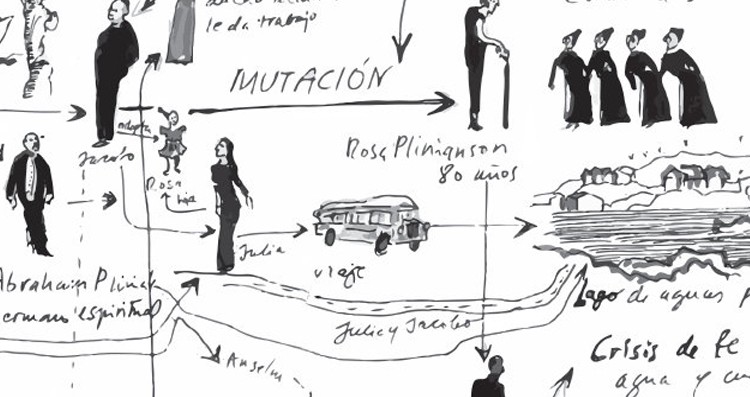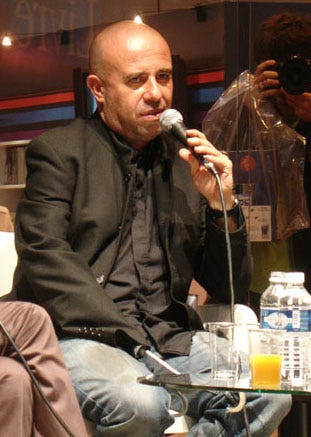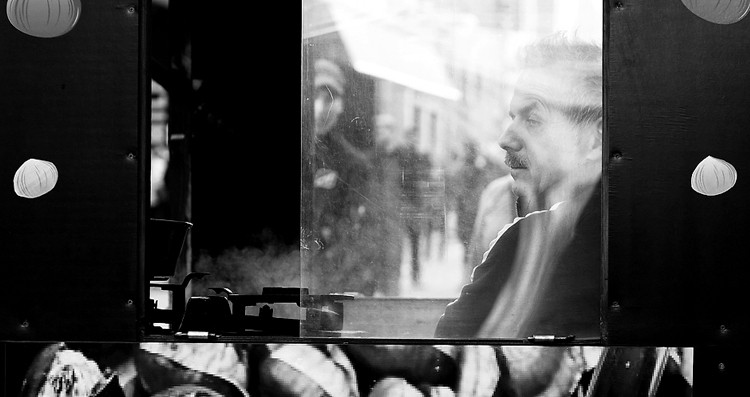Books & Culture
The Greatest Mexican Experimental Sufi Novelist You’ve Never Heard Of
Mario Bellatin’s mastery and why his work deserves to be read

Mario Bellatin begins his “autobiography” by talking about his balls.
1 — During the time that I lived with my mother it never occurred to me that adjusting my genitals in her presence could have any serious repercussions.
In the first of three stories contained in The Large Glass, wonderfully translated by David Shook, Bellatin’s mother fashions a string to tie and bind his young testicles into a unique sort of undergarment. She then forces him to exhibit his bulging and enlarged testicles at the public baths in town. The shame and confusion Bellatin feels at this charade is compounded by the fact that the spectators at the baths in turn pay his mother for this shame-filled privilege by giving her some of the small objects she collects, such as tubes of lipstick. He’s an unwilling prostitute.
The routine mortification of the public baths also has the side effect of giving his skin a strange, waxy luminosity. “My Skin, Luminous” is the title of the first of three “autobiographies” in the celebrated Mexican writer’s latest book. The story is one of three that also appeared in Bellatin’s first English book, Chinese Checkers, in a translation by Cooper Renner.
In that tale, Bellatin’s mother forbids anyone from touching his luminous skin; his body is her property, another object in her feverish collection. She, in turn, imprints her lipstick all over him, to mark him as hers. Reflecting retrospectively, Bellatin imagines that he could have applied a sort of diamantine powder to his soften glowing skin — the same sort of white texturing powder used in the shop class at his special school to “give real body to objects.” He must separate from his mother to reclaim his body and his self.
Each paragraph of “My Skin, Luminous” is numbered, from 1 to 363, which gives the story an easily digestible structure, much like a collection of epigraphs, a Buzzfeed listicle or, in Bellatin’s case, a Sufi hadith:
62 — “The rumors are true,” my mother told me one morning when she had woken up to show me her lips covered in an oily patina.
63 — “Many details about genital-displaying women are remembered, but everything about their exhibited sons is forgotten.”
64 — Later I found out that they killed them mercilessly.
Bellatin, or the unnamed narrator, lives in a small room behind his grandfather’s oven and attends a special school. It’s only after his father has abandoned the family that his mother performs a series of “experiments” on his body, ostensibly so that he can gain admission to this special school. One of these “experiments” involves smothering him with a pillow.
Readers of English, unaccustomed to Bellatin’s style or history might be tempted to take his testimony here at face value. Many readers expect a uniformity of experience or authenticity when approaching a book called an “autobiography.” Bellatin explodes that concept fully by his third autobiography in this short book. In “A Character in Modern Appearance,” Bellatin tells us that he is, in fact, a forty-six-year-old woman who speaks Castilian, drives a Renault, and has a German girlfriend. But then he backtracks and admits “I think I’m something of a liar. I repeat that it is not true that I had a German girlfriend.”

Some imperfections eventually disappear. It’s what time does to memory and what flowing water does to old stones. If you have never seen a photo of the man, the defining feature of Mario Bellatin’s body is his missing arm. He types with only one hand. He often uses prosthetic hands that look more like metal sculptures than humanoid body parts. And there is the matter of his bald head and his arresting eyes, all of which might add up to an intimidating figure if it were not for his smirk.
The physical deformities that he refuses to define him, and those which his mother imposes upon him, give him the advantage of being unmistakable outside of the public baths, which represent society. His corporeal body need not be present for him to leave an impression, though.
“A face for radio,” they say. Or “Politics is Hollywood for ugly people.” And so then writing is the ultimate bastion of the ugly, the deformed, the unpleasant — all of whom can transform the images of themselves through language.
In a recent article about his publishing travails, the New Yorker called Bellatin a “prankster” which denotes a lack of seriousness and belies the complexity of his true character. Despite that smirk, there are no laugh-out-loud pranks here. The Large Glass is a vessel containing a serious argument for separating the self from the world — and not just the metaphorical self but the actual, physical self.
Bellatin was raised in Peru, but moved to Cuba, and then Mexico, where he has lived since 1995. His sense of “the world” is expansive and, as a Peruvian Sufi, Bellatin has managed to fashion himself as an outsider in Catholic Mexico and literature in general. The realistic style of fiction, often associated with Mario Vargas Llosa in Peru, is anathema to Bellatin. He prefers the short parable to the multi-generational saga, the short allegory to the plot of a detective novel.
Whether or not these stories are autobiographies containing 100% true events or not seems to miss the point. The setting, the characters, the details of the literature, only serve to reinforce the persona that Bellatin continually disavows and then reinvents. The sheer limitations of his physical body have pushed him into inventing fluid new identities and fictional doppelgangers. Bellatin’s latest work fits with the contemporary trend in literature (c.f. Knausgaard, Ferrante, Heti, etc.) that ignores or dissolves the smooth line between fiction and memoir, the traditional boundary between “material” and fact. The quality of the storytelling intentionally outmaneuvers categorization.
In his interviews, Bellatin is defiantly oblique and contrarian. His indirect method transfers between his fiction and what he considers autobiography. He stubbornly resists easy classification and interpretation. A fiction writer will often withhold vital information to add intrigue or mystery to a story, but for a person to obfuscate their life story seems more hostile to the reader. But with Bellatin, it’s clear that any hostility he harbors is directed against abstract forms and artistic challenges rather than the actual reader. His willingness to flay his inner demons on the page is what gives his writing vitality and verve. Even in translation, writers capable of punching through the barriers of the “self” bring more value to the conversation than the moralists or careerists angling for a way into the zeitgeist.

The second of the three autobiographies, “The Sheikha’s True Illness”, most purely reflects Bellatin’s obsession with Sufism. However, he begins that story by discussing the dog-owning protagonists of his previous book (presumably Hero Dogs), as if he is not sure himself whether or not they are real characters that can be mentioned in this story. The meta-narrative he invents involves a dream-story-within-the-story called “The Sheikha’s Illness” which Bellatin sells to Playboy. In both the story and the dream story, it is while he is at the hospital to treat the unnamed but “incurable illness I suffer from” that he runs into the Sheikha, the matriarch of his religious community. She is seated in a wheelchair pushed by a dervish named Duja. But ultimately Bellatin cannot write about the Sheikha’s illness without confronting his own medical problems and throughout the narrative he returns to his own suffering and “the apparatus that atrophied my shoulder and part of my chest.”
Bellatin is able to hide his body through writing. Meeting him on the page, even in an autobiography, allows us to see past his one-armed body, or not see his body at all. Like a Sufi mystic, he enchants our attention away from his self and even his words, back on to our own selves.
“The eye should be the size of what it perceives,” I heard the sheikha say more than once. I never dared to ask what it was that that meant. What I did understand in a clearer way was when she told us that when the human being loves something he only loves the human being — he loves himself, his own attributes reflected in that which he says he loves.
He also tells us that “Sufism posits that we have completely forgotten the ideal world we come from” and this partly explains Bellatin’s preoccupation with dreams as they constitute a time that truly does not exist. The reality of their unreality leaves his body out of the equation altogether and allows his mind to scatter and roam free.
Without the baggage of emotions, family, nation, or identity. At my age something has happened in my circumstance that makes me feel like this. I think that is the best state in which to practice my work. Without worrying any longer that the strangeness of my body might be exhibited even naked, like a popular attraction.
If literature aims to make us less alone, we need writers like Bellatin who reflect not just a different perspective on life, but can envision something separate and apart, a periscope rising above the self.









